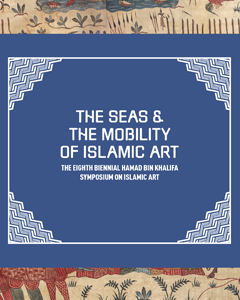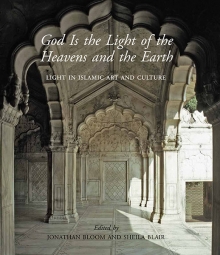
For the program of Islamic Art History and the Global Turn: Theory, Method, Practice please click here.

The papers delivered at the 2021 Hamad bin Khalifa Symposium on Islamic Art in Doha, Qatar, have been published in this Yale University Press publication, titled The Environment and Ecology in Islamic Art and Culture. The Islamic world finds itself increasingly at the epicenter of our escalating climate emergency, both as a locus of the petrochemical industry and as home to extraordinary landscapes in which the effects of environmental transformation are acutely felt. Yet, far from a solely twenty-first-century concern, engagement with changing, and often extreme, natural conditions has long characterized Islamic art and architecture in the central Islamic lands and beyond into the Muslim diaspora. This new book brings together a diverse group of scholars and critics whose contributions address this profound ecological awareness through the dual lenses of Islamic culture and climate change. Their case studies range from the Gulf, Iraq, Syria, the Indian Subcontinent, North Africa, and even outer space. Contributors examine the optimistic, sustainable, and innovative responses adopted by artists and builders in the face of often irreversible and escalating environmental destruction that necessitates such ingenuity. Breaking traditional disciplinary boundaries, this timely book brings together a diverse range of perspectives to bear on this increasingly urgent problem. The book can be purchased online or directly from Yale Press here.

For the program of The Environment and Ecology in Islamic Art and Culture, which was held online, please click here.

The papers delivered at the 2019 Hamad bin Khalifa Symposium on Islamic Art in Doha, Qatar, have been published in this Yale University Press publication, titled, The Seas and the Mobility of Islamic Art and Culture. The seas have long served as both connective tissue for and barriers between intellectual, social, and artistic traditions. Nowhere is this dual role more evident than within the visual and material cultures of the Islamic world. This remarkable new book brings together an international group of scholars and curators whose contributions address seafaring mobility’s profound effect on Islamic art. Their case studies range across the globe and span a period from Islam’s 1st century to today. Contributors examine the roles of importation and migration, travel, diplomacy, and gift giving in driving artistic innovation and changing the social, political, and religious institutions of an increasingly diverse Islamic world. Taken together, these chapters embody a distinctive big-picture approach, pulling an exceptional diversity of voices and topics into productive dialogue. The book can be purchased online or directly from Yale Press here.

For the program of The Seas and the Mobility of Islamic Art, held in Doha, Qatar please click here.

The papers delivered at the 2017 Hamad bin Khalifa Symposium on Islamic Art in Richmond, Virginia, have been published in this Yale University Press publication, titled, Islamic Art: Past, Present, Future. Based on a series of papers presented at the 7th Biennial Hamad bin Khalifa Symposium on Islamic Art in 2017, the essays in this volume grapple with these questions from a range of viewpoints. These texts—including beautiful illustrations of major works by contemporary artists from the Muslim world, including Newsha Tavakolian, Shahzia Sikander, Hassan Hajjaj and Lalla Essaydi—invoke a lively discussion of how the arts of the Islamic lands link the past with the present and the future. The book can be purchased online or directly from Yale Press here.

For the program of Islamic Art: Past, Present and Future, held in Richmond, Virginia – please click here.

The papers delivered at the 2015 Doha Symposium have been published in this Yale University Press publication. Exploring the central role of the written word in Islam and how writing practices have evolved and adapted in different historical contexts, this book provides an overview of the enormous impact that writing in Arabic script has had on the visual arts of the Islamic world. Approaching the topic from a number of different perspectives, the essays in this volume include discussions on the relationship between orality and the written word; the materiality of the written word, ranging from the type of paper on which books were written to monumental inscriptions in stone and brick; and the development of Arabic typography and the printed book. Generously illustrated, By the Pen and What They Write is an engaging look at how writing has remained a foundational component of islamic art throughout fourteen centuries. The book can be purchased online or directly from Yale Press here.

For the program of By the Pen and What They Write: Writing in Islamic Art and Culture, held in Doha, Qatar please click here.

The original papers delivered at the fifth biennial Hamad bin Khalifa Symposium on Islamic Art, held on November 9-11 2013 in Palermo, Italy have been edited and published by Yale University Press in a book that is now available for purchase. The Qur’an makes rich references to light, tying it to revelation, and light consequently permeates the culture and visual arts of the Islamic lands. God Is the Light of the Heavens and the Earth explores the integral role of light in Islamic civilization across a wide range of media, from the Qur’an and literature to buildings, paintings, performances, photography, and other works produced over the past 14 centuries.

For the program of God Is the Light of the Heavens and the Earth: Light in Islamic Art and Culture, held November 9-11 in Palermo, Italy, please click here.

The 13 original papers delivered at the fourth biennial Hamad bin Khalifa Symposium on Islamic Art, held at the Museum of Islamic Art in Doha in 2011, have been edited and published by Yale University Press in a book that is now available for purchase. The book includes essays on 12 objects owned by the Museum of Islamic Art by Francois Deroche, Kjeld von Folsach, Michael Franses, Aimee Froom, Julia Gonnella, Ruba Kana’an, Emilie Savage-Smith, John Seyller, Eleanor Sims, Antonio Vallejo Triano, Rachel Ward and Mohamed Zakariya. In addition, architectural critic Paul Goldberger discusses the museum, assessing its place in Pei’s career and in the broader scope of Islamic architecture, while Oliver Watson, the museum’s former director, sheds light on the installation of works throughout the building.

For the program of God Is Beautiful; He Loves Beauty: The Object in Islamic Art and Culture, held in October 2011, please click here.

The 12 papers delivered at the third biennial Hamad bin Khalifa Symposium on Islamic Art, held in Córdoba, Spain in 2009, have been edited and published by Yale University Press, and are now available for purchase. The book, titled And Diverse Are Their Hues: Color in Islamic Art and Culture, includes essays by Olga Bush, Maribel Fierro, Samir Mahmoud, Julie Scott Meisami, Lawrence Nees, Bernard O’Kane, Cheryl Porter, Noha Sadek, Michael Schreffler, Marianna Shreve Simpson, Manu Sobti & Mohammad Gharipour and Jon Thompson. This comprehensive volume is the first to analyze the use of color in Islamic art and architecture from a range of artistic and cultural perspectives. In it, a prestigious team of international scholars discusses the applications and implications of color in Islamic cultures from medieval to modern times and from Central Asia to Spain and beyond. They look at art, architecture, literature, philosophy, mysticism, optics, and conservation studies. Amply and vividly illustrated, And Diverse Are Their Hues is also a remarkable visual resource for Islamic carpets, ceramic tiles, manuscripts, gardens, and buildings.

For the program of And Diverse Are Their Hues: Color in Islamic Art and Culture, held in November 2009, please click here.

The 12 papers delivered at the Second Biennial Hamad bin Khalifa Symposium on Islamic Art, held in Doha, Qatar in 2007, have been edited and published by Yale University Press, and are now available for purchase. The book, titled Rivers of Paradise: Water in Islamic Art and Culture, includes an introduction by Editors and Symposium Organizers Sheila Blair and Jonathan Bloom and essays by Carole Hillenbrand, Yasser Tabbaa, D. Fairchild Ruggles, Linda Komaroff, Venetia Porter, Howayda Al-Harithy, Walter Denny, Marcus Milwright and Evanthia Baboula, Agnieszka Dobrowolska, Catherine B. Asher Perween Hasan and Mohammad Al-Asad. Copiously illustrated with beautiful color photographs and newly drawn plans and maps, this book will provoke readers to appreciate and acknowledge the essential, if often invisible and transitory, roles that water played in the arts of the Islamic lands and beyond.

For the program of Rivers of Paradise: Water in Islamic Art and Culture, held in 2007, please click here.


